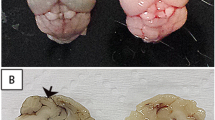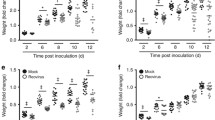Summary
The gerbil,Meriones unguiculatus, was investigated as a model for the encephalitic form of Rift Valley fever. Resistance to necrotizing encephalitis was age-dependent with 100% mortality at 3 weeks, decreasing to approximately 20% by 10 weeks of age in outbred gerbils inoculated subcutaneously. Fatal encephalitis in the 10-week-old adults was dose-independent [1.0–7.0 log10 plaque forming units (PFU), subcutaneously]. Viral replication and histological lesions were followed serially throughout the course of the infection in young (4 week) and adult (10 week) gerbils. Viral replication was evident in the brain tissue of young gerbils from day 4 (3.0 log10 PFU/g) through day 7 (6.0 log10 PFU/g), the last day the young gerbils survived. Virus was only detected in the brain tissue of a single adult gerbil (day 7, 4.0 log10 PFU/g) of 26 studied in the sequential survey. In contrast, two moribund adult gerbils had approximately 7.0 log10 PFU/g of virus in the brain tissue on days 8 and 11. When young and adult gerbils were inoculated with a low dose (50 PFU) of virus intracranially, there were no detectable differences in the course of infection with all animals succumbing to fatal necrotizing encephalitis aproximately 7 days postinoculation. The young gerbil becomes the first animal model in which uniformly fatal RVFV-induced encephalitis is produced without significant extraneural lesions.
Similar content being viewed by others
References
Anderson GW Jr, Smith JF (1987) Immunoelectron microscopy of Rift Valley fever viral morphogenesis in primary rat hepatocytes. Virology 161: 91–100
Anderson GW Jr, Slone TW Jr, Peters CJ (1987) Pathogenesis of Rift Valley fever virus in inbred rats. Microbial Pathogen 2: 283–293
Balducci M, Fausto AM, Verani P, Caciolli S, Renzi A, Paci P, Amaducci L, Leoncini F, Volpi G (1985) Phlebotomus-transmitted viruses in Europe. Comparative studies on their biology, ecology, epidemiology, and pathogenicity. In: Pozzi L (eds) Proc Int Cong Infect Dis, Cairo, Edizioni Luigi Pozzi, Rome, pp 101–104
Centers for Disease Control and National Institutes of Heath (1984) Biosafety in microbiological and biomedical laboratories, 1st edn. U.S. Department of Health and Human Services, Public Health Services, Washington, D.C., pp 74–89
Earley E, Peralta PH, Johnson KM (1967) A plaque neutralization method for arboviruses. Proc Soc Exp Biol Med 125: 741–747
Ehrnst A, Peters CJ, Niklasson B, Svedmyr A, Holmgren B (1985) Neurovirulent Toscana virus (a sandfly fever virus) in Swedish man after visit to Portugal. Lancet 1: 1212–1213
Johnson RT (1982) Viral infections of the nervous system. Raven Press, New York, pp 37–56
Kitchen SF (1950) The development of neurotropisms in Rift Valley fever virus. Ann Trop Med Parasitol 44: 132–145
Laughlin LW, Girgis NI, Meegan JM, Strausbaugh LJ, Jassin MW, Watten RH (1978) Clinical studies on Rift Valley fever: 2. Ophtalmologic and central nervous system complications. Egypt Public Health Assoc 53: 183–184
Maar SA, Swanepoel R, Gelfand M (1979) Rift Valley fever encephalitis. A description of a case. Cent Afr J Med 25: 8–11
Peters CJ, LeDuc JW (1984) Bunyaviruses, Phleboviruses and related viruses. In: Belshe RB (ed) Textbook of human virology. PSG Publishing Company, Inc., Littleton, pp 547–598
Peters CJ, Meegan JM (1981) Rift Valley fever. In: Beran GW, Steele JH (eds) CRC handbook series in zoonoses, vol 1. CRC Press, Boca Raton, pp 403–423
Peters CJ, Reynolds JA, Slone TW, Jones DE, Stephen EL (1986) Prophylaxis of Rift Valley fever with antiviral drugs, immune serum, an interferon inducer, and a macrophage activator. Antivir Res 6: 285–297
Peters CJ, Anderson GW Jr (1981) Pathogenesis of Rift Valley fever. In: Swartz TA, Klingberg MA, Goldblum N (eds) Contributions to epidemiology and biostatistics, S Karger, New York, pp 21–41
Peters CJ, Slone Jr TW (1982) Inbred rat strains mimic the disparate human response to Rift Valley fever virus infection. J Med Virol 10: 45–54
Smith JF, Pifat D (1982) Morphogenesis of Sandfly fever viruses (Bunyaviridae family). Virology 121: 61–81
Smithburn KC (1949) Rift Valley fever virus: the neurotropic adaptation of virus and experimental use of this modified virus as a vaccine. Br J Exp Pathol 30: 1–16
Subcommittee on Arbovirus Laboratory Safety of the American Committee on Arthropod-borne Viruses (1980) Laboratory safety for Arboviruses and certain other viruses of vertebrates. Am J Trop Med Hyg 29: 1359–1381
Velden DJJ, Meyer JD, Oliver J, Gear JHS, McIntosh B (1977) Rift Valley fever affecting humans in South Africa: a clinicopathological study. S Afr Med J 52: 417–418
Author information
Authors and Affiliations
Additional information
In conducting the research described in this report, the investigators adhered to the “Guide for Care and Use of Laboratory Animals”, as prepared by the Committee on Care and Use of Laboratory Animals of the Institute of Laboratory Animal Resources Commission on Life Sciences-National Research Council. The facilities are fully accredited by the American Association for Accreditation of Laboratory Animal Care.
The views of the author(s) do not purport to reflect the positions of the Department of the Army or the Department of Defence (Paragraph 4-3, AR 360-5).
Rights and permissions
About this article
Cite this article
Anderson, G.W., Slone, T.W. & Peters, C.J. The gerbil, Meriones unguiculatus, a model for Rift Valley fever viral encephalitis. Archives of Virology 102, 187–196 (1988). https://doi.org/10.1007/BF01310824
Received:
Accepted:
Issue Date:
DOI: https://doi.org/10.1007/BF01310824




